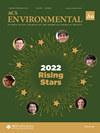Facing Global Climate and Environmental Change
IF 6.7
Q1 ENGINEERING, ENVIRONMENTAL
引用次数: 0
Abstract
G environmental change is real in the Anthropocene. Global warming is happening now, caused by anthropogenic activities with the emission of greenhouse gases. The latest reading of “the Keeling curve” has topped 424 ppm of carbon dioxide, which represents the highest record in continuous measurements of CO2 at Mauna Loa Observatory in Hawaii since 1960. Climate change has become more prominent and more evident that we experience it even in our daily life. Weather events have intensified with recordshattering climate extremes. This winter, we experienced record-breaking rainfall and snowfall associated with the atmospheric river in the West of the United States, while facing off against heat in the East of the United States. Biomass burning and wildfires have increased with higher frequency, longer durations, and longer seasons. Hurricanes have become more frequent and stronger, causing flooding in various places around the globe. These extreme events in a warming planet disrupt and negatively impact our society, restructuring our lifestyles in a myriad of ways, e.g., in sports: a recent study showed that global warming causes a reduction in ballpark air density, promoting more home runs in Major League Baseball games (bad news for pitchers!). Even though they are managed separately, climate change is coupled with air quality. There are cobenefits of climate regulations on improving air quality, but so far there is a lack of tools to rigorously evaluate the implications of addressing these challenges simultaneously. Sebastian D. Eastham and colleagues developed a computationally efficient approach to quantify how combined climate and air quality interventions affect air quality outcomes. Their approach captures spatial heterogeneity and complex atmospheric chemistry involving ozone, nitrogen oxides, volatile organic compounds, ammonia, and particulate matter, enabling rapid assessments modeling air quality−climate interactions. They demonstrate that air quality impact of climate policy depends on precursor emission stringency. In addition to greenhouse gases, particulate matter containing chromophores, so-called brown carbon, affects the climate by posing positive radiative forcing and serving as cloud condensation nuclei (CCN). The chemical composition and climate-relevant properties of brown carbon are highly dynamic, as they evolve upon chemical transformation in the atmosphere. Borduas-Dedekind and colleagues tackle this problem by irradiating lab-generated and field-collected brown carbon samples. They specifically focused on investigating photomineralization, a photodegradation process that fragments organic molecules to CO and CO2. They found that the rates of photomineralization were fastest for lab-generated samples and slowest for ambient brown carbon samples. Despite photobleaching and composition changes in the brown carbon, its CCN abilities did not change substantially. There are three more exciting publications in this issue. Kanel, Nadagouda, and colleagues review the groundwater contamination of arsenic (As), which can pose serious health risks. They summarize the origin, geochemistry, occurrence, mobilization, and microbial interaction of natural and anthropogenic-As, and common remediation technologies for As removal from groundwater. Pickering, Julian, and colleagues systematically reviewed the prevalence and concentrations of fecal indicator microorganisms and enteric pathogens on hands, and highlighted the importance of standardizing hand sampling methods. Finally, Guest and colleagues introduced an open-source multicriteria decision analysis package that enables users to transparently compare sanitation and resource recovery alternatives and characterize the opportunity space for early stage technologies. We sincerely thank these authors and reviewers for their contributions to these publications. We hope you enjoy reading these interesting articles in our latest issue. Manabu Shiraiwa orcid.org/0000-0003-2532-5373面对全球气候和环境变化
本文章由计算机程序翻译,如有差异,请以英文原文为准。
求助全文
约1分钟内获得全文
求助全文
来源期刊

ACS Environmental Au
环境科学-
CiteScore
7.10
自引率
0.00%
发文量
0
期刊介绍:
ACS Environmental Au is an open access journal which publishes experimental research and theoretical results in all aspects of environmental science and technology both pure and applied. Short letters comprehensive articles reviews and perspectives are welcome in the following areas:Alternative EnergyAnthropogenic Impacts on Atmosphere Soil or WaterBiogeochemical CyclingBiomass or Wastes as ResourcesContaminants in Aquatic and Terrestrial EnvironmentsEnvironmental Data ScienceEcotoxicology and Public HealthEnergy and ClimateEnvironmental Modeling Processes and Measurement Methods and TechnologiesEnvironmental Nanotechnology and BiotechnologyGreen ChemistryGreen Manufacturing and EngineeringRisk assessment Regulatory Frameworks and Life-Cycle AssessmentsTreatment and Resource Recovery and Waste Management
 求助内容:
求助内容: 应助结果提醒方式:
应助结果提醒方式:


